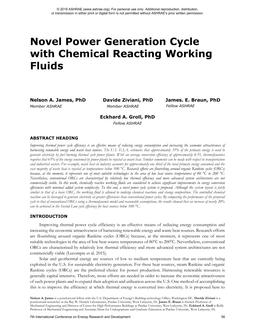Description
Improving thermal power cycle efficiency is an effective means of reducing energy consumption and increasing the economic attractiveness ofharnessing renewable energy and waste heat sources. The U.S. E.I.A. estimates that approximately 35% of the primary energy is used togenerate electricity by fuel burning thermal cycle power plants. With an average conversion efficiency of approximately 0.35, thermodynamicsrequires that 65% of the energy consumed by power plants be rejected as waste heat. Similar comments can be made with respect to transportationand industrial sectors. For example, waste heat in industry accounts for approximately one third of the total primary energy consumed and thevast majority of waste heat is rejected at temperatures below 100 °C. Research efforts are flourishing around organic Rankine cycles (ORCs)because, at the moment, it represents one of most suitable technologies in the area of low heat source temperatures of 80 °C to 200 °C.Nevertheless, conventional ORCs are characterized by relatively low thermal efficiency and more advanced system architectures are notcommercially viable. In this work, chemically reactive working fluids are considered to achieve significant improvements in energy conversionefficiencies with minimal added system complexity. To this end, a novel power cycle system is proposed. Although the system layout is fairlysimilar to that of a basic ORC, the working fluid is allowed to undergo chemical reactions and change composition. The controlled chemicalreaction can be leveraged to generate electricity at greater efficiencies than conventional power cycles. By comparing the performance of the proposedcycle to that of conventional ORCs using a thermodynamic model and reasonable assumptions, the results showed that an increase of nearly 20%can be achieved in the Second Law cycle efficiency for heat sources below 100 °C.
Citation: 7th International Conference on Energy Research and Development
Product Details
- Published:
- 2019
- Number of Pages:
- 8
- Units of Measure:
- Dual
- File Size:
- 1 file , 850 KB
- Product Code(s):
- D-2019ICERD7-008




